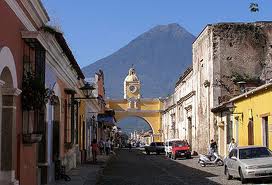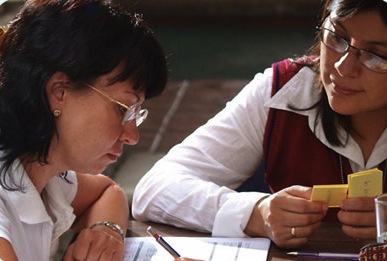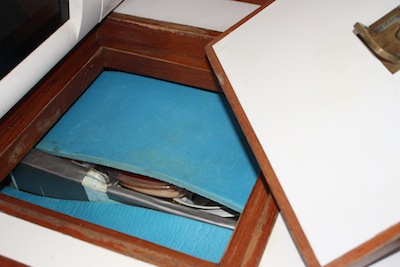I am a professional student when it comes to learning Spanish. Over the years, I’ve tried everything and then some, starting with 4 years of Spanish in high school, followed by 2 years in college. Needless to say, I learned almost nada (that’s nothing in English). 🙁
I’m sure some of the immersion programs for younger students are worthwhile, but as a general observation, learning a language in a high school or college classroom is useless. Mainly because the emphasis is on memorization of grammar principles rather than learning to use the language. I hope this is changing.

After 6 years of academic study, I discovered on a trip to Spain – only a year or two after graduating from college – that I had retained almost nothing of what I had learned over those six years.
So when we decided to leave to go cruising and chose the Western Caribbean as our initial six year cruising grounds, I knew I had to learn some of the language to gain a better experience of “living with the locals”. From Mexico to Belize (who’s primary language is supposed to be English, but it’s not like any English you’re probably familiar with), to Guatemala and the Rio Dulce, I became more committed to learning the language. So two years before we actually left to go cruising, I started studying …. again.
 The first thing I did was spend hours shopping at the local Borders bookstore to buy some self-study books and then a cassette language program (this was in the days before computers were so prevalent). Needless to say, maybe I refreshed a few palabras (words), but I didn’t learn much.
The first thing I did was spend hours shopping at the local Borders bookstore to buy some self-study books and then a cassette language program (this was in the days before computers were so prevalent). Needless to say, maybe I refreshed a few palabras (words), but I didn’t learn much.
Then I got the best idea I ever had! I called the local International Center and asked if they had any private tutors for Latin American Spanish. I was so lucky! They referred me to Diana, who’s husband had been recently transferred to Indianapolis from North Carolina but they were from Colombia! I had too few lessons with Diana, but she was a marvel! Lessons consisted of a workbook – her choice but directly from Borders – but more than that, it was a total hour of speaking NOTHING but Spanish. Everything was in Spanish! Lessons were twice a week and I loved it. We learned vocabulary & grammar via the workbook and homework, but the real learning started the minute I walked through Diana’s front door. Anything that we discussed, the lesson, the weather, her little girl, my kids, anything at all, had to be discussed in Spanish. Aaarrrggg!!! Needless to say, the first few lessons were torture and I unfortunately I never got really good. Sometimes we did “field trips” to the local Mexican grocery, to a regular hardware store, anywhere, but the rules said we could speak nothing but Spanish. Wow!
Unfortunately, I had to move away before I felt comfortable conversing, but Diana had awakened me to the FUN that I’d be missing if I didn’t learn to converse with the people where we would be cruising.
So back to the drawing board. Just about this time, I saw a Rosetta Stone advertisement on the computer (by then computers were more prevalent) and I downloaded the “trial” course. I was hooked! It wasn’t as good as the interaction I had with Diana, but at least it was interaction. I liked the fact that the program includes pictures and even situational videos as you progress through the lessons and wasn’t only memorization. For whatever reason, most of what I learned in a lesson with the Rosetta Stone course stuck!
I worked my way through Latin American Spanish Level 1 fairly quickly, the first year we were cruising. Then I ordered 2 & 3, the only options available at the time and continued my studies through the following years in the Western Caribbean. I also supplemented with local language lessons in the Rio Dulce and Antigua, Guatemala – see below.
If you want to try Rosetta Stone for free, now there’s an online demo available here: Rosetta Stone Online Demo

At the end of our first six months cruising, I spent a month studying one on one, twice a week, with a local tutor on the Rio Dulce, then a week studying at the Christian Spanish Academy in Antigua, Guatemala – up in the highlands and well worth some inland exploration, not just for Spanish lessons! Some tutors are better than others, in the Rio, I only learned to memorize more words, but it expanded my vocabulary.

When we checked into Guatemala at Livingston at the mouth of the Rio Dulce river the first time, the officials came out to our boat and four of them sat in our cockpit in stony silence. I struggled to communicate and take care of all the forms and answer their questions in Spanish until they laughed at my pronunciation and switched to perfect English. If you try to communicate in THEIR language (after all you ARE in THEIR country), officials that pretend they don’t speak a word of English will often help you out and your check-in will be easier, plus you’ll be able to find out all kinds of things about their town that you wouldn’t know if you didn’t bother to learn any language.
 Another must have aboard is Kathy Parson’s “Spanish for Cruisers” (or “French for Cruisers”). These great little spiral bound books feature pictures of key items in cruisers lives (like parts of a diesel!) and phrases we really need. And they’re easy to throw in a backpack during a trip to town and if you get stuck, you can even just point to a picture. Language doesn’t have to be perfectly fluent to be understood perfectly!
Another must have aboard is Kathy Parson’s “Spanish for Cruisers” (or “French for Cruisers”). These great little spiral bound books feature pictures of key items in cruisers lives (like parts of a diesel!) and phrases we really need. And they’re easy to throw in a backpack during a trip to town and if you get stuck, you can even just point to a picture. Language doesn’t have to be perfectly fluent to be understood perfectly!
I am by NO means fluent, however, I was able to converse enough to do the police report after we were robbed in Utila, to figure out where to get our alternator rebuilt in Colon (after looking all over Panama City for a new one to buy), buying provisions and just generally conversing with the local population. They’re always as curious about us as we are about them and there’s nothing better than being invited in to local celebrations and traditions!
If I were starting to learn Spanish all over again, before I left to go cruising, my first option would be to find a native Spanish speaker that was willing to do private tutoring.
If that wasn’t possible, I’d invest in the Rosetta Stone course and diligently work my way through it. I found that even though I progressed through the lessons, I didn’t feel like I was retaining it until we were off cruising in the winter and I could actually remember and speak the language — well, maybe speak is a bit strong, but communicate between gestures and words, whether or not the grammar is correct! 🙂 I am sure there are other courses equally as good, maybe better, these days, but Rosetta Stone is the one I’m familiar with. Do your research, try the free demos and choose the one that’s right for you!

I am also a firm believer in learning some of the language of whatever countries you plan to visit. When we were in Kuna Yala (San Blas Islands) Panama, the Kuna speak primarily Kuna. Spanish is just now beginning to invade the youngsters because it’s being taught in schools on the islands. We made index cards with key Kuna words and phrases (click here for my post on Interacting With Local Culture). The kids got a kick out of our index cards and were constantly helping us with our pronunciation. The adults that spoke Spanish would help too, adding phrases to our cards in Kuna and helping us with the pronunciation. None of which would have been possible without a base understanding of Spanish, as very few spoke any English.
Since we’ve been away from cruising the Western Caribbean for over two years now, my Spanish has suffered immensely; however, I am sure if we were to travel to a Spanish speaking country, I would pick it back up easily. And in the meantime, I play with the Coffee Break Spanish and other online resources available now that weren’t available when I first started learning a language.
Anyone else have tips on learning a language? I may need to learn another language before leaving to go cruising again … maybe French for the Eastern Caribbean? 🙂 Please leave a comment and let us know what worked for you! Cheers! Jan
















A couple of other things contrary to what those high school classes teach — you DON’T have to speak in complete sentences, people will understand if you only use the present tense, and the most important thing is to open your mouth and TRY! If nothing else, you’ll all share a laugh.
Years ago, I remember being in a grocery store in Peru and wanting honey but I didn’t know the word and it wasn’t in my pocket dictionary. I acted out a bee buzzing and them did the YUM thing . . . everyone in the store laughed and I got honey!
Oh yeah, they also taught me that the word was “miel.”
🙂 too funny! I love the story!
We have been using the Pimsleur CDs with great success. They teach you the same way you learn as a child, all spoken. We also found a meetup.com Spanish Language group that meets once a week near our house. We go there and speak nothing but Spanish for 3 hours while we drink café and discuss whatever anyone wants to discuss. I used to live in Chile when I was a child but had lost it all, and my husband had never spoken it so we wanted to get pretty proficient before casting off the dock lines. I think it’s extremely important to show the people of the country you are visiting that you have at least made a concerted effort at learning their language.
Deb
S/V Kintala
http://www.theretirementproject.blogspot.com
Good for you! I’m always amazed at cruisers that make absolutely NO effort to learn any local language from the countries they’re visiting – how RUDE! I’ve heard good things about Pimsleur program, so thanks for commenting. I haven’t tried it myself, so I can’t comment. 🙂 I bet the meetup.com Spanish Language group reinforces your learning even more! That’s a great idea, even if it’s just another couple, get together and speak nothing but Spanish (or whatever language you’re learning) for a couple of hours once a week! We tried this with other cruisers over a game night – usually Mexican Train – once a week while we were waiting for weather to leave the marina on the Rio Dulce, Guate.
If anyone else has had a good experience with other language programs, please leave a comment and share so everyone knows the scope of possibilities! THANKS! Jan
Everything is very open with a precise description of the challenges. It was truly informative. Your site is very useful. Many thanks for sharing!
I also have tried just about most things; classes, Michel Thomas CD’s , books and am still really bad. I have started Duolingo and like it a lot. Unfortunately I have to be online so it only works in marinas, but it is helping me speak as well as write spanish. It comes in several languages and is free.